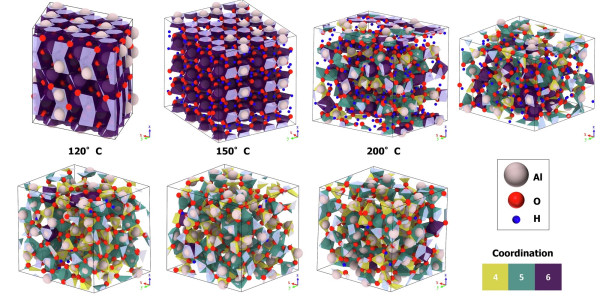Machine learning helps study the behavior of hydrogen in thin alumina films
By Nicola Nosengo/NCCR MARVEL
Hydrogen may seem the simplest chemical element of the periodic table, with just one proton and one electron. But this does not mean that studying its behavior is without challenges. For example, scientists have so far struggled to model what happens when hydrogen is incorporated into thin films manufactured through atomic layer deposition (ALD). This increasingly popular technique can be used to homogeneously coat any surface and is applied to create alumina barrier coating, for example, for the inner barrier shell of a hydrogen storage container. It’s important to anticipate how this alumina coating would interact with stored hydrogen, because scientists know that if hydrogen atoms are incorporated in the film, they can negatively affect its performance. But typical atomic simulation techniques fail to tackle the problem. “Atomic layer deposition is a very slow process that takes hours or even days, depending on the thickness of the coating,” explains Vladyslav Turlo, a senior scientist at Empa in Thun in the Laboratory for Advanced Materials Processing. “It is simply impossible to model the growth process with classic simulation techniques”.
Neither can experiments alone solve the problem. Directly probing hydrogen’s local chemical bonding state in the amorphous structure of the thin film is impossible. At best, X-ray photoelectron spectroscopy (XPS) can do it indirectly by analyzing hydrogen’s effects on other elements.
In a study just published in npj Computational Materials, Turlo and his group introduce a new, fast atomistic simulation technique that leverages XPS data, machine learning, and molecular dynamics techniques to model amorphous alumina structures with realistic hydrogen contents.

Analysis of five amorphous alumina polymorphs with different H/Al ratios and densities as well as of (from left to right) crystalline sapphire and bayerite. Adapted from Gramatte et al. npj Comput Mater (2025).
As Turlo explains, the first challenge was to find a method to accurately represent the structure of ALD coatings. “Most groups approach the problem by assigning the system a specific concentration obtained from experiments, and then using computational methods to simulate melting and quenching of the melt,” he says. “We found this method does not work for hydrogen-supersaturated phases, because the material is intrinsically metastable and once you heat it, it decomposes into oxides and water”. To be able to model the system, instead, one needs to maintain OH groups instead of water molecules.
The solution chosen by the research team was to start from a highly defective crystal hydroxide structure, and then randomly remove OH groups and hydrogen atoms from it until the percentage of aluminum, hydrogen, and oxygen matched the one measured by experiments. After this passage, the material was heated, in simulation, to the deposition temperature, which varies from room temperature up to 200 degrees Celsius. In the end, says first author Simon Gramatte, who was doing a PhD on the topic at Empa’s Laboratory for Advanced Materials Processing, the simulated structures match the experimental density very well. “We have a technique that, by overlapping experimental data with theoretical structures, can probe indirectly the chemical state of hydrogen in surfaces, and that is potentially useful for different applications”.
The work was enabled by accurate interatomic potentials (the mathematical tools that allow for the description of the potential energy of a system of atoms) obtained via machine learning, using a foundational graph neural network. ”It’s a nice demonstration that foundational models can work well for materials simulation,” says Turlo. “You just tell the model what elements you want to use, and it isolates the systems to run the simulation”.
The simulations revealed that hydrogen content critically influences chemical state: higher hydrogen levels favor OH ligands, while lower contents promote diverse hydrogen bonding environments.
For the future, the group envisions another potential application of their work. “We want to design hydrogen purification membranes based on alumina films produced by ALD,” says Turlo. When supersaturated films are annealed, Turlo explains, nanoscopic pores are formed with water. “In the simulation, water has no way to escape, but in real experiments, we know that it starts bubbling and evaporates, so you get these tiny pores that can be used later on for gas separation. We hope we can control nicely the porosity of the film until we get such tiny pores that they will filter everything apart from hydrogen”. Even if that was not the case, the system could be used for CO2 or other greenhouse gases with larger molecules. “What is nice about it is that simulations inspired an idea, the experimentalists had not thought about”. Turlo says his group will now work with experimentalists at Empa to continue this direction of research.
“On the theoretical side, we are working to better model X-ray photoelectron spectroscopy, the experimental technique that enabled the analysis,” says Turlo. “We are collaborating with Giovanni Pizzi’s group at the Paul Scherrer Institute, that develops the AiiDA workflow to perform quantum calculations and predict XPS binding energies”.
Reference
Gramatte, S., Politano, O., Jakse, N. et al. Unveiling hydrogen chemical states in supersaturated amorphous alumina via machine learning-driven atomistic modeling. npj Comput Mater 11, 170 (2025). https://doi.org/10.1038/s41524-025-01676-5
Low-volume newsletters, targeted to the scientific and industrial communities.
Subscribe to our newsletter